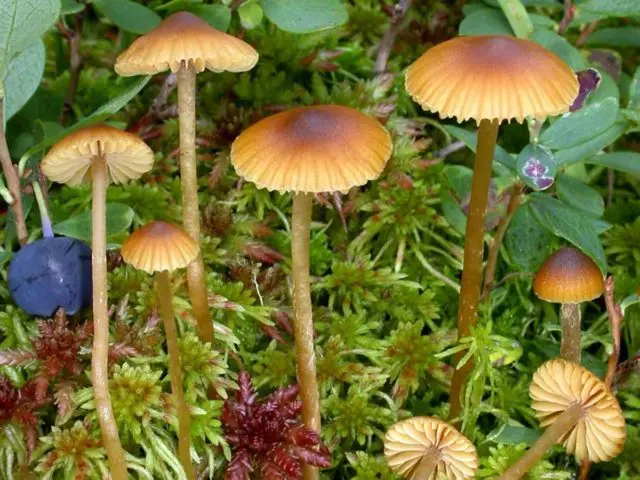Contents
Galerina sphagnum is a representative of the Strophariaceae family, the genus Galerina. This mushroom is quite common throughout the world, often found in coniferous and deciduous forests of South and North America, Europe and Asia.
What does sphagnum gallery look like

Galerina sphagnum is a fruiting body with a pronounced hat and a thin stem, has the following characteristics:
- In young mushrooms, the cap has a conical shape, and with age it becomes hemispherical, in some cases flat. Its diameter varies from 0,6 to 3,5 cm. The color can be brown or ocher; when dried, it acquires a light yellow tint. The surface is smooth, but fibrous margins can be traced in young specimens. During heavy rains it becomes sticky.
- Her plates are narrow and frequent. At a young age, they are painted in a light ocher color, with time they acquire a brown tint.
- Spores ovoid, brown. On the basidia, there are 4 spores at the same time.
- The leg of this species is hollow, smooth and fibrous, reaches up to 12 cm in length. As a rule, the color matches the hat. A young mushroom has a ring on its stem, which quickly disappears when it grows up.
- The flesh of the sphagnum gallerina is thin, watery and brittle. Usually the color can be similar to the hat or lighter by several tones. Aroma and taste are almost imperceptible.

Where does galerina sphagnum grow?
A favorable time for the development of sphagnum galerina is the period from June to late autumn, but active fruiting occurs from August. With a warm long autumn, this specimen can be found even in November. For them, coniferous and deciduous forests, as well as swampy areas are preferable. They grow mainly on decayed hardwood and coniferous wood, on stumps and moss-covered soil. They can grow both individually and in small families. This species is quite common, and therefore can be found in almost any corner of the world, perhaps with the exception of only Antarctica.
Is it possible to eat galerina sphagnum
Despite the fact that sphagnum gallerina does not belong to the category of poisonous, it is not an edible mushroom, since it does not represent any nutritional value. Experienced mushroom pickers do not recommend experimenting and using it for food, since the toxic properties of this species have not been fully studied. It should also alert the fact that most of the fungi of the genus Galerin are poisonous and can cause serious damage to the body.
How to distinguish from twins
Quite often, novice mushroom pickers confuse the specimen in question with edible mushrooms. To avoid misunderstandings, it is necessary to pay attention to the following features of these species.

- If a dubious specimen was found in a coniferous forest, then the mushroom picker is dealing with a gallery. You should know that mushrooms do not grow in this area, and for the species in question, the coniferous forest is a favorite place.
- As a rule, sphagnum galerina grows singly or in small clusters, and mushrooms prefer to be located in groups.
- Another difference is the ring of mushrooms. It should be borne in mind that a young sphagnum galerina can also have it, however, when growing up, the ring quickly disappears and only a small trace remains of it.
Conclusion
Galerina sphagnum is a common species that can be found almost anywhere in the world. However, this specimen is an inedible mushroom and, accordingly, is not recommended for human consumption. Despite the fact that its toxicity has not been proven, it is not worth putting yourself at risk. In the search for edible gifts of the forest, one should be as careful as possible so as not to mistakenly bring a little-studied specimen. If there is even the slightest doubt about the mushroom found, it is better to leave it in the forest.









